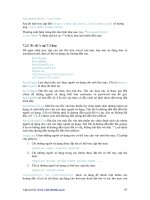QUẢN TRỊ hệ điều HÀNH mã NGUỒN mở
Bạn đang xem bản rút gọn của tài liệu. Xem và tải ngay bản đầy đủ của tài liệu tại đây (8.05 MB, 572 trang )
QUẢN TRỊ
HỆ ĐiỀU HÀNH MÃ NGUỒN MỞ
Lê Nhật Duy, PhD.
Blog: Lnduy.wordpress.com
Email:
Nội dung chương trình
Mục tiêu môn học
Môn học cung cấp các kiến thức cơ bản về hệ
điều hành Linux và quản trị Linux.
Thời lượng
Lý thuyết
: 30 tiết
TỰ HỌC: 60 TiẾT
2
Nội dung chương trình
TT
Nội dung chương trình
1
Introduction Linux
2
Using Linux text editor
3
Managing the Linux file system
4
Working with Users and Groups
5
Install and managing software
6
Using the Linux shell
7
Managing processes and services
8
Managing the Linux Boot Process
9
Linux network services
3
Kiểm tra đánh giá
Kiểm tra giữa kỳ
Tiểu luận theo nhóm (3->5 SV)
Thi kết thúc môn
4
Giáo trình và TLTK
Tài liệu học tập
Robb H. Tracy, Mc Graw Hill, CompTIA Linux+
Certification Study Guide
Tài liệu tham khảo
Slides bài giảng của giảng viên
Bộ bài tập thực hành Linux 1, Linux 2 (IUH)
5
Tài liệu tham khảo
Câu hỏi thường gặp với new user for linux
/> Hỏi-đáp về Linux: /> Diễn đàn thảo luận Linux:
Các tài liệu tiếng việt về linux
/>=7209
6
Tài liệu tham khảo
về openSUSE
Trang chính
Trang tiếng Việt />Trang tiếng Anh />
Giới thiệu, hướng dẫn cài đặt, sử dụng các bản openSUSE, và các ứng
dụng đi kèm
/> Kho phần mềm do openSUSE cung cấp
/> Tài liệu hướng dẫn sử dụng openSuSe của Novell
hay
/> Forum về openSUSE
/>
7
Chapter 1
Introduction to Linux
1
Overview
What is Linux
The History of Linux
Linux Distributions
Common Linux Roles
Components of Linux
User interface
2
What is Linux ?
Linux is an operating system,
provides key functions in a computer system:
Application Platform
Hardware Moderator
Data Storage
Security
Connectivity
3
What is Linux ?
Linux is an Unix-like operating system
Linux is an free and open source software
Linux is a leading server operating system
Multi-user, security, stability, …
4
The Function of Linux..
Application Platform: An operating system
provides applications with a platform where they
can run, managing their access to the CPU and
system memory.
Hardware Moderator: The operating system
also serves as a mediator between running
applications and the system hardware ( such as
memory, hard drives, and communication ports
…)
5
The Function of Linux..
Data Storage : The operating system is also responsible
for providing type of file system that organizes the
information in an easily retrievable format.
Security: The operating system is responsible for
providing a degree of security for the data it hosts. The
system administrator can create rules and grant rights that
determine who can access what information.
Connectivity: The operating system manages
connectivity between computer systems using a variety of
network media and interfaces, including infrared,
Ethernet, and wireless.
6
The History of Linux
GNU/Linux
7
The History of Linux
Richard Matthew Stallman (born March 16, 1953), is an
American software freedom activist and computer program
Is a student at Harvard University
a programmer at the MIT Artificial Intelligence Laboratory
In September 1983, he launched the GNU Project to create a
free Unix-like operating system
With the launch of the GNU Project, he initiated the free
software movement. In October 1985, he founded the Free
Software Foundation, and in 1989 he wrote the GNU General
Public License (GNU GPL)
8
The History of Linux
By the early 1990s, many of the programs required in the
GNU project’s operating system (such as libraries,
compilers, text editors, a Unix shell, and a windowing
system) were completed, although low-level elements
such as device drivers, daemons, and the kernel were
stalled and incomplete.
In 1991, in Helsinki, Linus Torvalds began a project that
later became the Linux kernel
Development was done on MINIX using the GNU C compiler
9
The History of Linux
The first release of the Linux kernel, Linux 0.01, included
a binary of GNU's Bash shell
In 1992, he suggested releasing the kernel under the GNU
General Public License.
He first announced this decision in the release notes of version
0.12.
In the middle of December 1992 he published version 0.99 using
the GNU GPL
Linux and GNU developers worked to integrate GNU
components with Linux to make a fully-functional and
free operating system.
10
GNU - GPL
Tác giả vẫn giữ bản quyền đối với với phần mềm gốc.
Người sử dụng có quyền :
Tự do chạy chương trình, cho bất cứ mục đích nào.
Tự do tái phân phối bản sao.
Tự do tìm hiểu cách hoạt động của chương trình, tự do sửa đổi
nó và phát hành những gì sửa đổi ra công cộng.
Người sử dụng có thể thay đổi một phần của chương trình và phân
phối thay đổi của mình cùng toàn bộ phần mềm cho người khác,
với điều kiện nói rõ phần mình thay đổi.
Phải đảm bảo cung cấp mã nguồn khi bán một sản phẩm theo
GNU GPL để người khác có thể sử dụng và/hoặc bán tiếp. Người
dùng kế tiếp có đầy đủ quyền lợi như của người trước.
11
Linux Distributions
A Linux distribution (also called GNU/Linux
distribution or distro for short ) is a member of the
family of Unix-like operating systems
built on top of the Linux kernel
consist a set of libraries and utilities from the GNU
project
12
Linux Distributions ..
Linux distributions have taken a wide variety of forms
Commercial or non-commercial;
Designed for enterprise users, power users, or for home users;
Supported on multiple types of hardware, or platform-specific,
even to the extent of certification by the platform vendor;
Designed for servers, desktops, or embedded devices;
General purpose or highly specialized toward specific machine
functionalities (e.g. firewalls, network routers, and computer
clusters);
Built primarily for security, usability, portability, or
comprehensiveness.
13
Linux Distributions …
Today there are hundreds of different
distributions available popular
■ SUSE Linux
■ Fedora Linux
■ Red Hat Enterprise Linux
■ Debian Linux
■ CentOS
■ ALT Linux
■ Gentoo Linux
■ TurboLinux
■ Mandrake Linux
■ Lycoris Linux
■ Linspire
■ Ubuntu
■Slackware Linux
14
Linux Distributions …
15
Roles of Linux
Desktop operating system
Server operating system
Firewall
16
Roles of Linux
Linux on the Desktop
Linux is the desktop OS
Advantage
Cost : Linux is free and open source, so cost is very small vs
Windows
Software : supplied by vendor and third-party with number of
huge softwares
Hardware : hardware requirements for Linux is lower than for
windows. Linux is perfect for the old computers.
Security : the security of Linux is much stronger than of
Windows
17
Roles of Linux
Linux as a Server
Linux can assume a variety of server roles
File Server Using the Network File System (NFS) or
Samba service, Linux can be configured to provide
network storage of users’ files.
Print Server Using the Common UNIX Printing
System (CUPS) and Samba services together, Linux
can be configured to provide shared printing for
network users.
Database Server Linux works great as a database
server. There are a variety of database services
available for Linux servers, including MySQL and
PostgreSQL.
18









